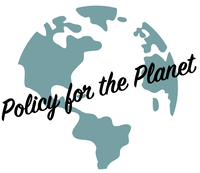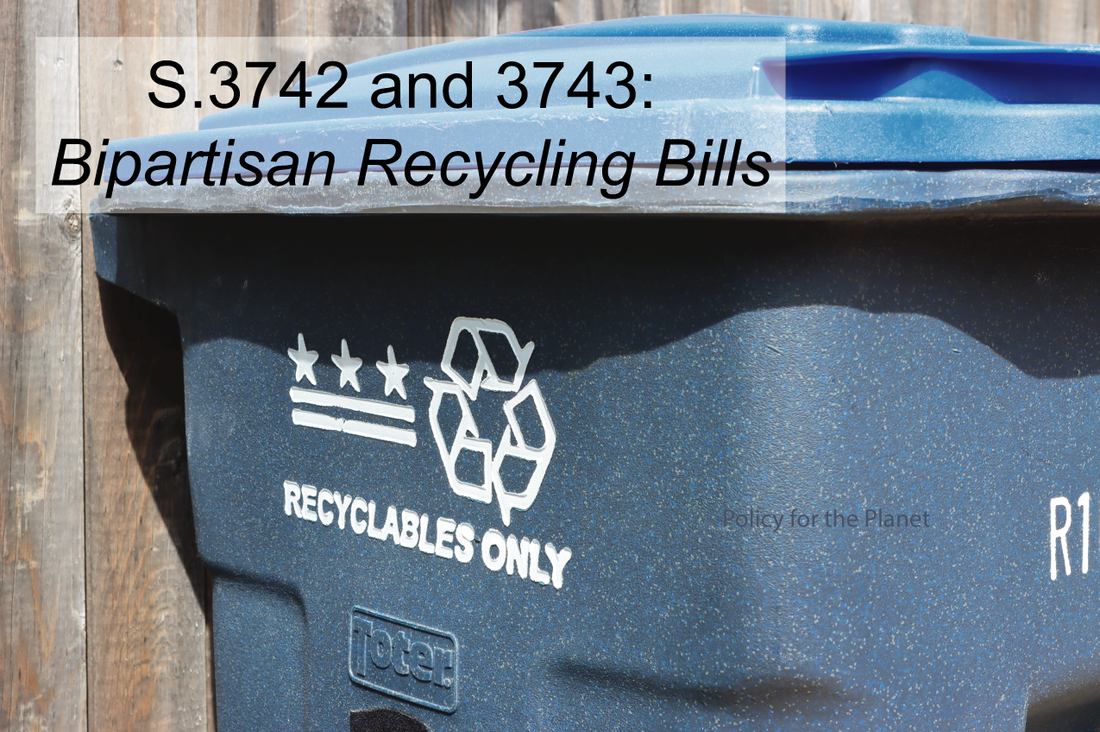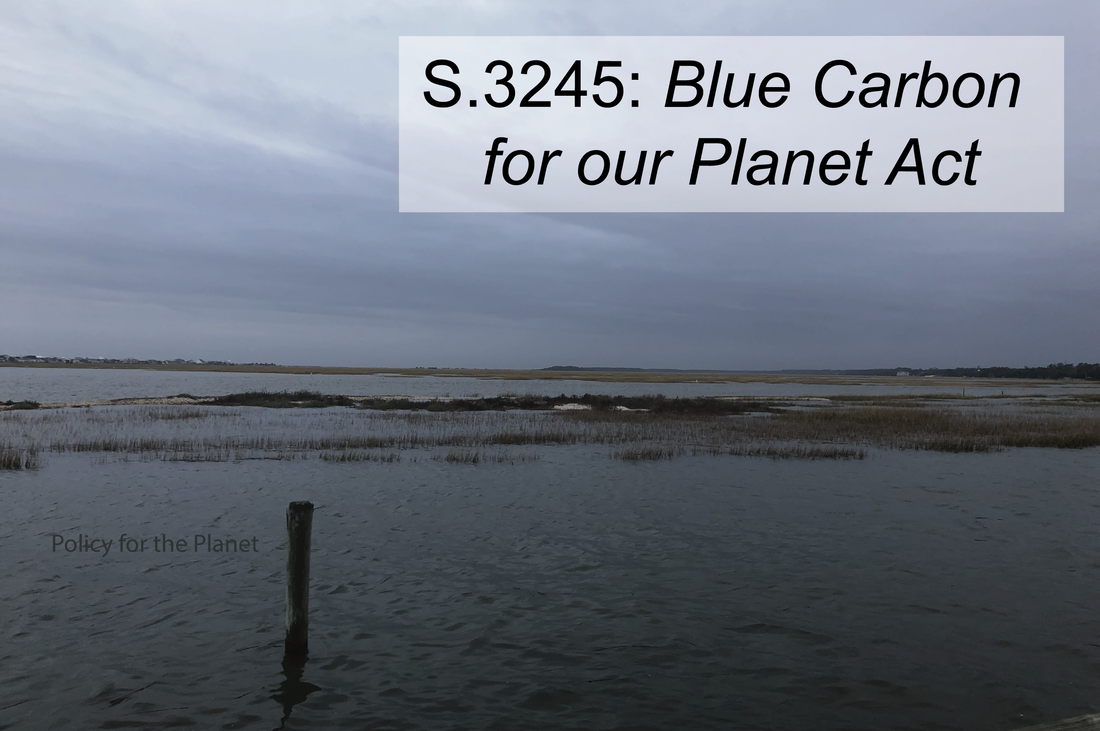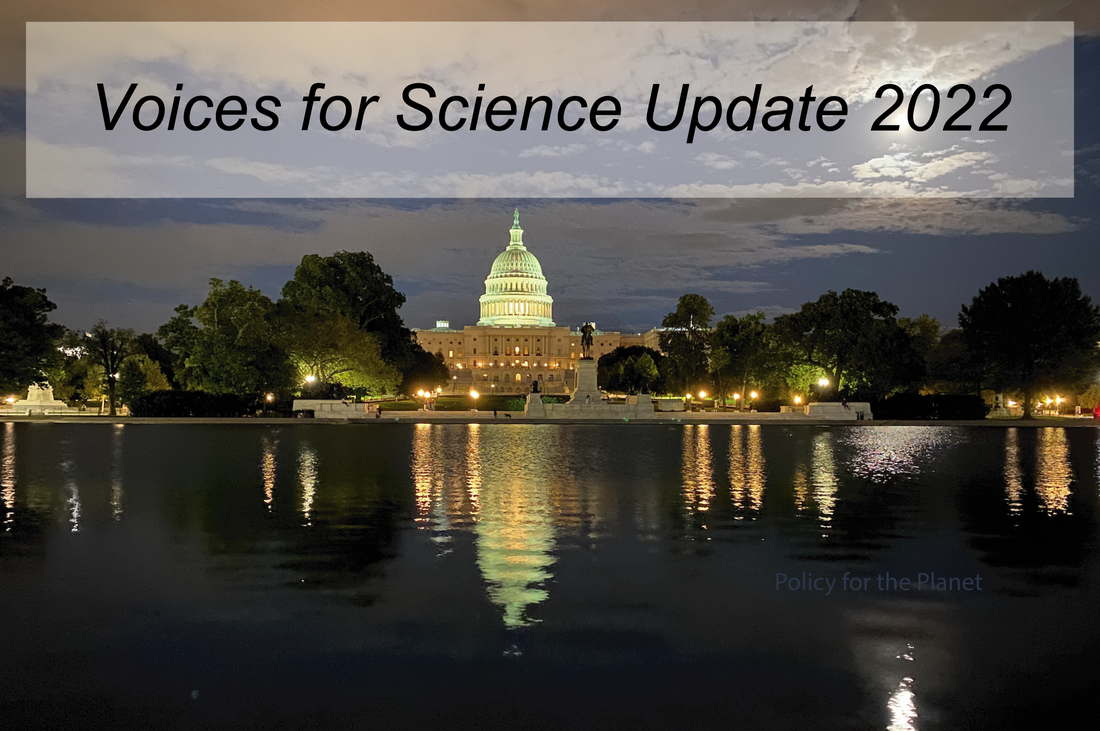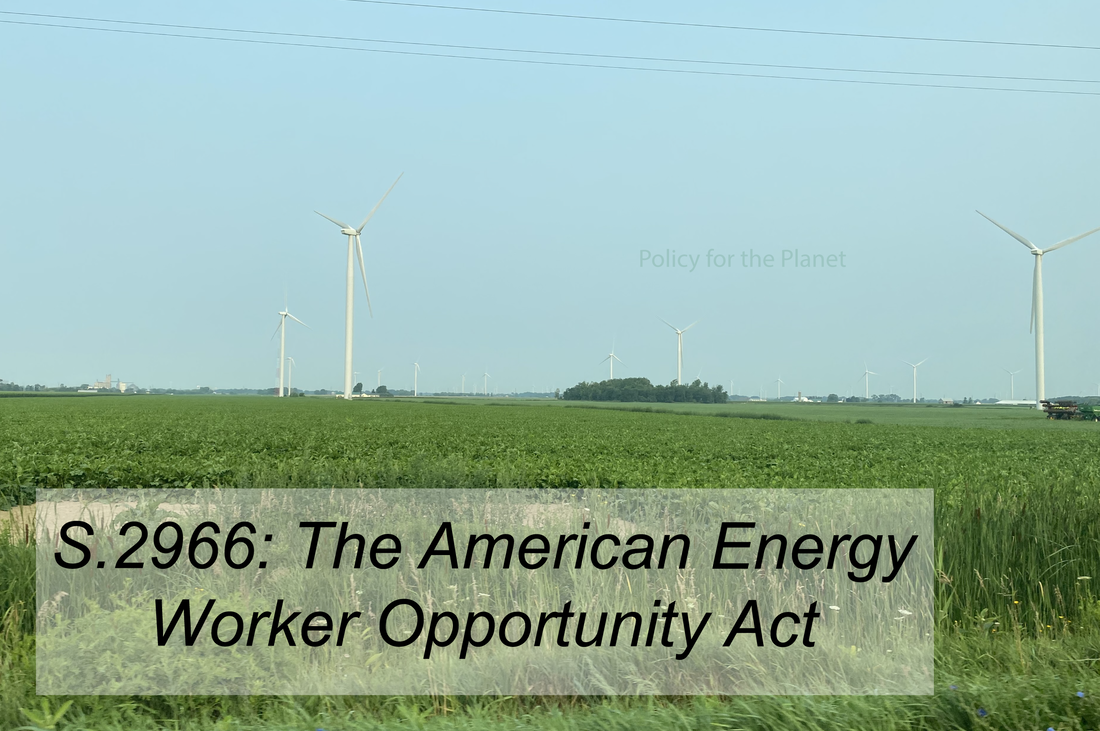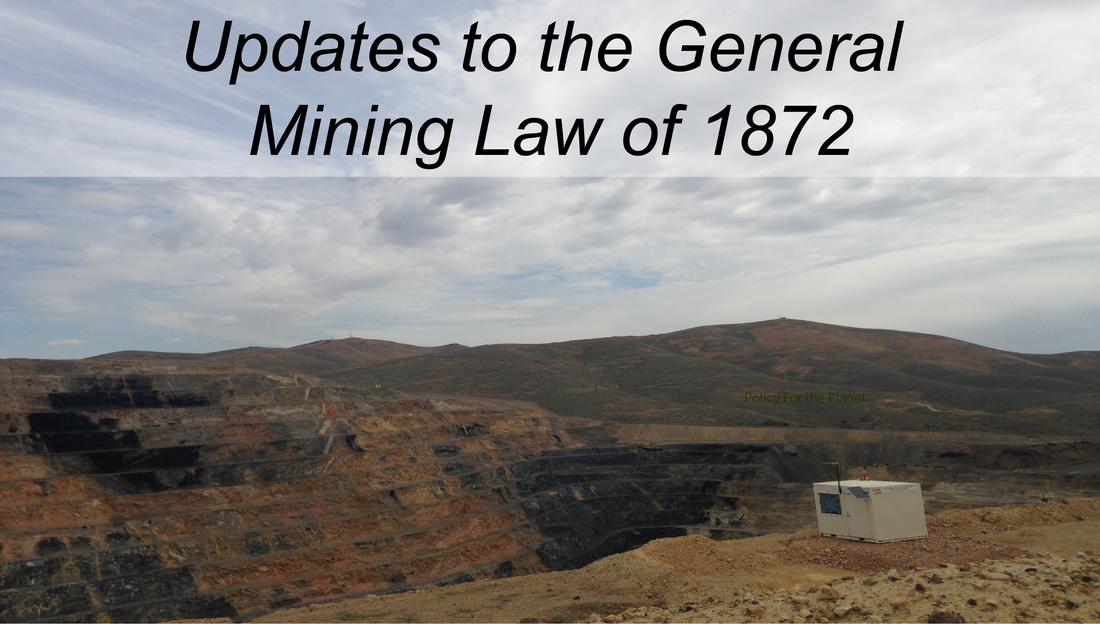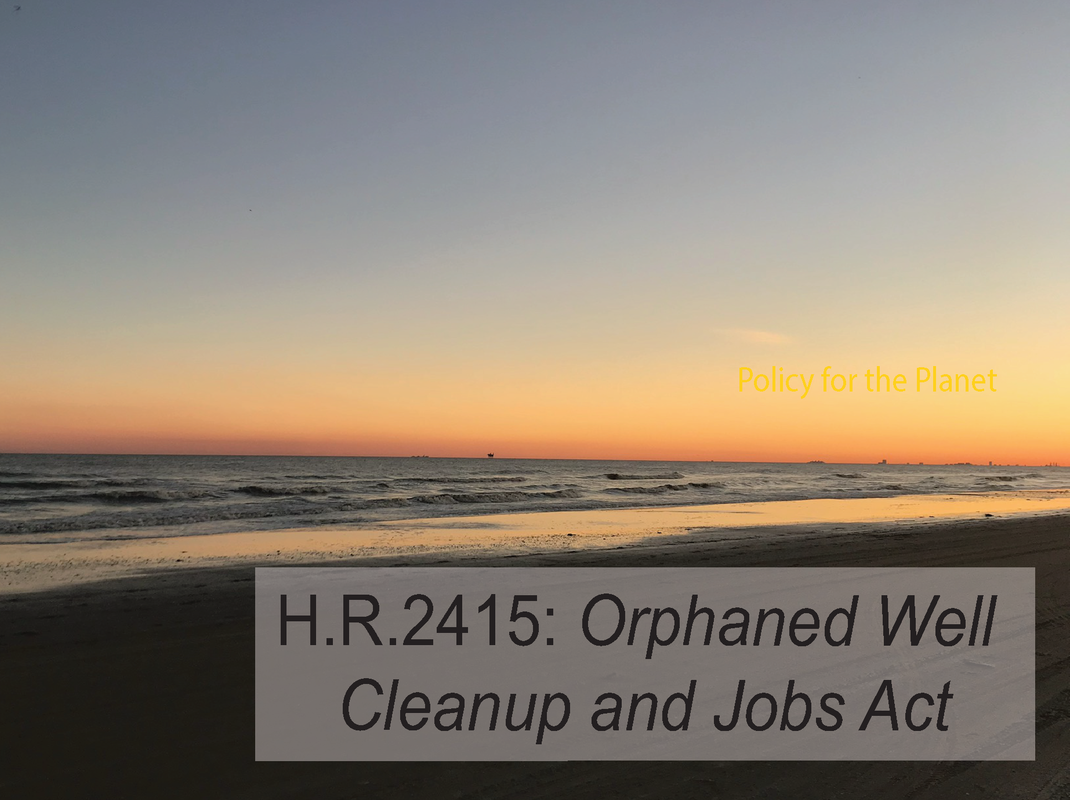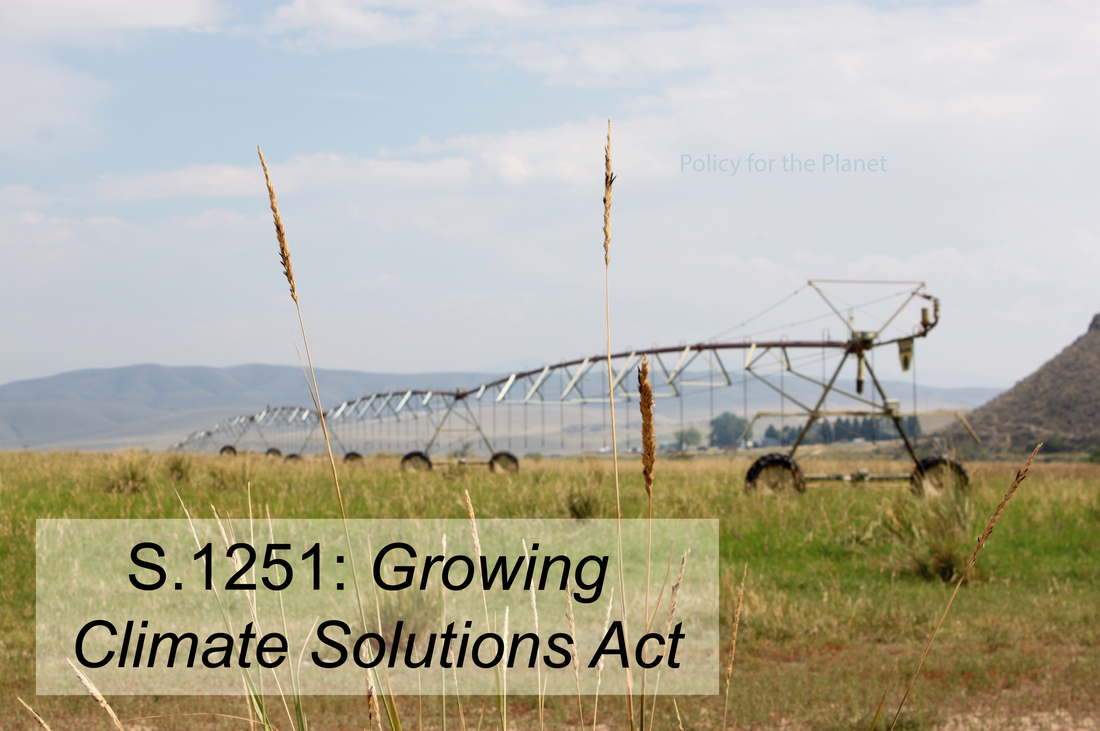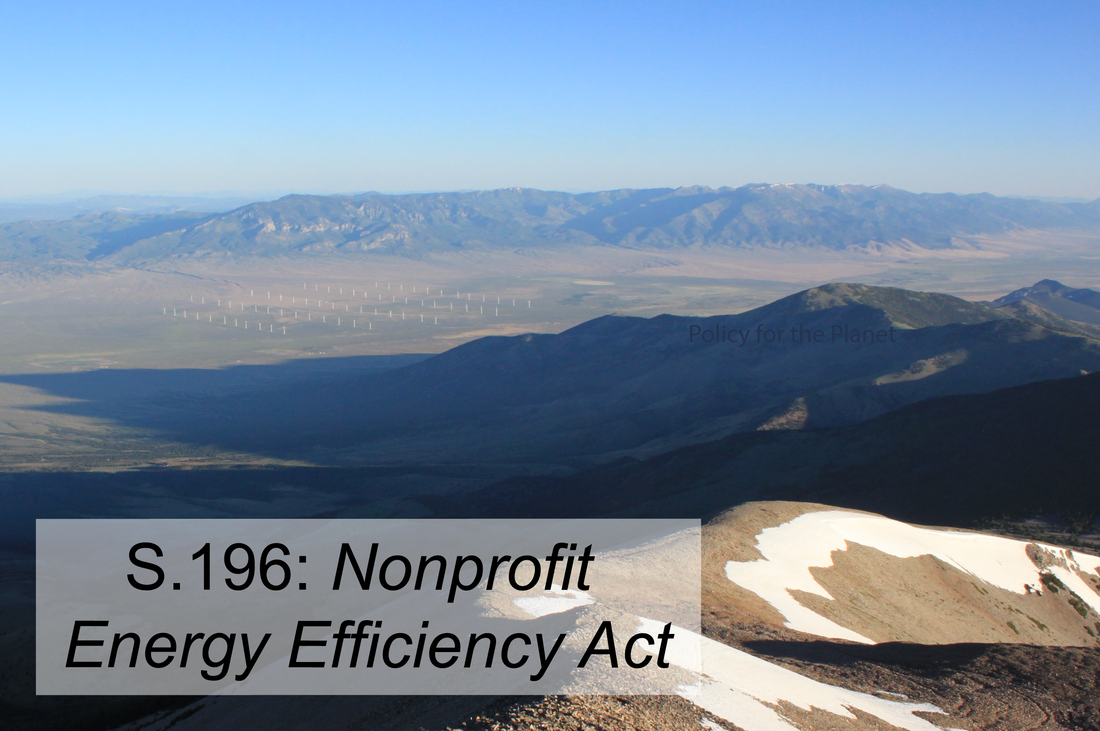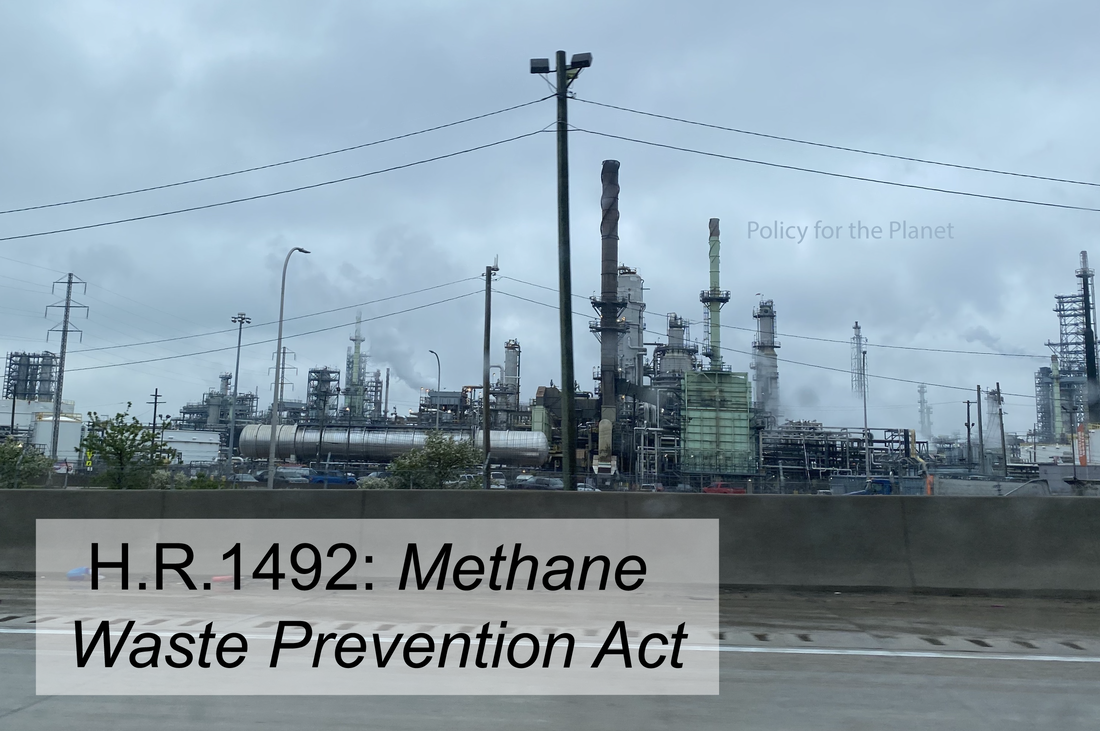|
“When we look at opportunities for reducing pollution and waste and creating good-paying jobs domestically, recycling is an area that unites most Americans” -- Senator Tom Carper
THE BILLS: S.3742 Recycling Infrastructure and Accessibility Act S.3743 Recycling and Composting Accountability Act What do the Bills do?
Why were they proposed?
Benefits
Challenges
“The reality of Congress” (what the outlook of this bill looks like) These bills were introduced with bipartisan support, and as of 4/7/2022 is in the markup stage in the Environment and Public Works Committee. Want to advocate? Lawmakers Chairman Tom Carper (D-DE), Ranking Member Shelley Moore (R-WV) and John Boozman (D-AK), introduced two bipartisan bills addressing recycling and composting in the Senate Environmental and Public Works Committee in early March. Footnotes
1 Comment
Blue Carbon for Our Planet Act: Protecting Coastal Habitats that have the Ability to Store Carbon2/21/2022 The Blue Carbon for Our Planet Act was introduced in the Senate on November 18, 2021 by Senator Lisa Murkowski [R-AK] on behalf of herself and Senator Whitehouse [D-RI]. Senators Murkowski and Whitehouse co-chair the Oceans Caucus. The Bill was read twice and referred to the Committee on Commerce, Science, and Transportation. An identical Bill was introduced in the House by Representative Suzanne Bonamici [D-OR-1] on behalf of herself, Bill Posey [R-FL-8], Donald Beyer Jr [D-VA-8], and Brian Mast [R-FL-18]. The House Bill was read twice and referred to the Natural Resources, Science, Space, and Technology, and House Administration committees.
THE BILL: S.3245 H.R.2750 “From Rhode Island to Alaska, our oceans are in trouble. The coastal wetlands that make up the first line of defense against climate change are rapidly disappearing. Our bipartisan bill would help preserve the tidal marshes, mangroves, seagrasses, and kelp forests that provide a natural buffer to rising seas and absorb vast amounts of carbon dioxide from the atmosphere” -- Senator Whitehouse. What does the Bill do? In short, the Blue Carbon for Our Planet Act is an effort to protect, restore, and conserve the nation’s blue carbon ecosystems. Blue carbon is a term that is used to describe carbon that is sequestered and stored by the world's oceans and coastal ecosystems. Examples of these habitats include mangroves, tidal marshes, wetlands, seagrasses and kelp forests -- all ecosystems that help stabilize the coasts. These habitats can capture carbon from the atmosphere and other sources and can store it in both the biomass for years to decades, and in soils for hundreds to thousands of years. To accomplish these protection and restoration efforts, the Bill would establish the Interagency Working Group (IWG) on Coastal Blue Carbon, which would oversee the development and maintenance of a national map of these ecosystems, including specific habitat types, condition, size, and protected status, among other things. The map would also portray an assessment of the potential for carbon sequestration, methane production, and net greenhouse gas reduction in each area. The goal is that this will be a tool for local-level conservation, planning, and restoration efforts. Additionally, the IWG would work to identify barriers to conserving and restoring these coastal blue carbon ecosystems, including climate-induced vulnerabilities such as sea-level rise and ocean acidification. The IWG will work in collaboration with the National Academies of Sciences, Engineering, and Medicine to create a national strategy for studying the effects of human and environmental stressors (including climate change) on the ability of these systems to sequester carbon and thrive. The strategic plan will include federal investments in multiple aspects of coastal blue carbon ecosystem projects, from fundamental research to their development, and deployment. They will also place an emphasis on data availability and accessibility, including from the Coastal Carbon Data Clearinghouse. From this work, the Group will then establish national priorities to conserve and restore blue carbon ecosystems. For these efforts, the Bill authorizes $15,000,000 each year from Fiscal Years 2022-2026. Why was it proposed? Coastal blue carbon ecosystems like mangroves and tidal marshes provide numerous benefits to society and the environment. They protect coastal areas from flooding, help to retain soil and beach sand, and prevent erosion. Additionally, the ecosystems help to purify the surrounding water, provide a home to resident fish and wildlife, and can fuel local economies. As the severe and unrelenting impacts of climate change worsen, these ecosystems, where present, serve as a buffer and provide some coastal protection while simultaneously removing carbon from the atmosphere. Therefore, as the impacts from climate change continue to become more severe with stronger and more frequent storms and rising sea levels, restoration and conservation efforts in these areas are essential for building resilience. The climate crisis on Earth today is caused by humans burning fossil fuels like coal, oil, and natural gas. Burning fossil fuels releases greenhouse gasses like carbon dioxide (CO2) into the air, which can seep into the ocean (1). The National Academies recently released a study focused on the importance of understanding methods and technologies for removing carbon dioxide from seawater in order to provide information on how to restore impacted environments and the integrity of existing technologies. For a more in-depth breakdown, check out the National Academies report (2). Benefits The Blue Carbon for our Planet Act provides a bipartisan and natural effort to help the United States reach a net zero carbon goal by 2050. Protecting and conserving these valuable ecosystems not only accesses a natural capture for atmospheric carbon, but preservation of these areas also is essential for maintaining coastal ecosystems and surrounding wildlife. Ensuring the security of these areas will also play a major role in natural resilience as society continues to adapt to the demands of a changing climate over the next several years. This includes stabilizing coastlines as sea levels rise, and also providing a natural buffer to protect coastal communities in severe weather events. Challenges One key challenge to this legislation is that it will take a lot of work and time to map the ecosystems and ensure functionality of datasets. Additionally, Congress at the moment is focused on other major priorities, like federal budget appropriations for FY22 and FY23, as well as passing some version of Build Back Better and the Supreme Court nomination process all during an election year. Patience for passing this legislation will likely be key. The reality of Congress (what the outlook of this bill looks like) Govtrack notes that this Bill has a 13% chance of becoming law (3). This Bill was introduced and is supported by members of both Republican and Democratic parties, indicating a Congressional acknowledgement that coastal ecosystems have an important impact on areas regardless of party lines. Want to advocate? This Bill currently has 2 co-sponsors in the Senate, Senators Whitehouse [D-RI] and Susan Collins [R-ME]. In the House, the 7 co-sponsors include Bill Posey [R-FL-8], Donald Beyer Jr. [D-VA-8], Brian Mast [R-FL-18], Chellie Pingree [D-ME-1], Derek Kilmer [D-WA-6], Peter DeFazio [D-OR-4], and Jared Huffman [D-CA-2]. Do you see your Congresspeople listed above? If not, you can email your policymakers by finding their emails at https://www.congress.gov/members?searchResultViewType=expanded or call their offices to voice your thoughts. Remember to use our Resources page for more information and guidance when reaching out! Footnotes Policy for the Planet celebrates 1 year! How Voices for Science helped to launch this website1/13/2022 Policy for the Planet just celebrated its 1 year anniversary! It’s hard to believe we’ve been writing posts and summarizing legislation for over a year now! It seems only fitting to give another shout out post to the American Geophysical Union’s (AGU) Voices for Science (VFS) program, as it played a big role in our efforts to launch this blog, and it’s taking applications for the 2022-2023 cohort through February 1. Last year, we wrote a post about Morgan’s experience with the VFS program, which trains scientists to effectively communicate science to different audiences. Participants are selected for one of two tracks based on their interests: communications, where they learn how to speak with journalists, media, and public audiences, or policy, where they learn how to build relationships with policymakers at the federal, state, or local levels. We both participated in the policy track. Once participants are selected and participate in training with the full cohort, they’re then split into smaller groups by geographic location and have an AGU policy staffer as their mentor for the year. Under their tutelage, each person develops an engagement plan, and then meets with their regional groups once a month to discuss progress and get feedback. Participants design their own projects and come up with their own ideas to conduct outreach either solo, in collaboration with others in the program, or other people interested in helping with the project(s). Our policy track cohort members came up with some great ideas, like conducting science policy fellowship or career webinars, writing policy op-eds and memos, and beginning podcasts, among many other things. While Morgan was a member of the 2020-2021 VFS cohort, we collaborated to start this website! After an awesome AGU Congressional Visits Day experience (virtual, of course) meeting with Representative Stauber, and staffers from Senator Smith, Senator Klobuchar, and Representative Omar’s offices, we began to understand the important role that scientists can and should play in the policy process. We decided that we wanted to continue reading and learning about science policy. Preparing for Congressional visits was a surprisingly academic exercise, from researching policy makers, reading science-based legislation and drawing connections between the two. Throughout this process we learned just how much environmental legislation is out there! Our goal was (and still is) to encourage awareness of science in policy by using our expertise to bring visibility to proposed environmental legislation and communicate it in a more digestible form. This endeavor took a lot of planning and thought, but with the mentorship of Morgan’s VFS cohort, we came up with the idea for Policy for the Planet! While designing the website and ironing out details, we also presented an introduction to science policy to our department, and led a state-level water policy discussion with interested scientists in industry and academia. This year, Mary joined the VFS program’s policy track for the 2021-2022 cohort and continued what we started. We both recently graduated with our PhDs and moved on to science policy positions in Washington, DC -- and truly owe our start in science policy to the opportunities created through VFS. While settling into new routines and adjusting to the fast pace of DC life has taken most of our focus, the VFS program has kept us motivated and on track with Policy for the Planet. Mary’s cohort is and has been a major source of support for the website. We’re not done yet -- we have a vision for PFTP and the website is still in progress. There is a lot to come in 2022 as we continue to build our platform and follow along with Congress’ historic investments in the environment and climate change mitigation. If you’re interested in VFS there is still time to APPLY for next year’s cohort! Applications for the 2022-2023 year are open through February 1: https://www.agu.org/Share-and-Advocate/Share/Sharing-science-network/Voices-for-science The American Energy Worker Opportunity Act was introduced in the Senate on October 10, 2021 by Senator Sherrod Brown [D-OH] on behalf of Senators Bob Casey [D-PA], Sheldon Whitehouse [D-RI], Tammy Baldwin [D-WI], Michael Bennet [D-CO], Tammy Duckworth [D-IL], Tina Smith [D-MN], and Elizabeth Warren [D-MA]. The bill was read twice and referred to the Committee on Finance.
THE BILL: S.2966 “As we transition to a clean energy future, we cannot leave workers in these industries behind. The American Energy Worker Opportunity Act would create a worker-centered plan to support workers, their families and communities that have relied on fossil-fuel production as our energy needs change. Our Build Back Better budget makes major investments in renewable energy, and we must use this once-in-a generation opportunity to support our energy workforce through this transition.”--Senator Tammy Baldwin What does the Bill do? The goal of this partisan bill is to provide resources and training opportunities to help transition workers supported by the fossil fuel industry to the clean energy industry so that they are not displaced, or “left behind.” This transition program includes supplemental wages, health benefits, education and training funds, and educational benefits for children of laid off workers. This program will be overseen by the Office of American Energy Workers which will be established within the Department of the Treasury, and will take effect on the date that this new office is established. Workers are eligible to participate if their employment is terminated from a coal mine or fossil-fuel intensive plant due to closure of the facility, and prior to the closure, the worker must have been employed for at least 12 months working at least 30 hours a week. The closure in this scenario indicates any reduction in production that has associated permanent layoffs after the date the bill is enacted. Eligible workers will receive a wage replacement at least once a month that is equal to the amount the individual was making during the 12 month period prior to termination, and that will be substantial enough to allow the individual to maintain health benefits as well as contribute to their retirement. Wage supplements will also be adjusted each calendar year for inflation. Additionally, eligible workers will be provided the opportunity to partake in training through the form of grants, that will help them to make a career transition. Finally, eligible workers with children will be given educational grants for their children up to and including a four-year degree. Why was it proposed? There is currently a global shift towards clean energy alternatives to fossil fuels in an effort to slow the rate at which the climate is warming. Currently, the natural gas industry employs 437,300 people, the petroleum industry employs 681,500 people, and the coal industry employs 164,700 people (1), providing stability for families in the form of good paying jobs and health benefits. These workers have been essential in ensuring that there is accessible and reliable electricity that fuels homes and stimulates the economy, and it is irresponsible and unfair to leave them behind as the country pushes forward towards a renewable future. As this global transition to clean energy alternatives increases exponentially, we face the possibility of a massive workforce shortage as well as increasing unemployment rates as the need and production of fossil fuels gradually slows (2,3,4). Benefits There is currently a huge shortage in the renewable energy workforce, so transitioning workers from fossil fuel to the renewable energy sector where possible could catalyze a change and provide many employment opportunities (5). The transition could be set up to allow workers with learned skills in certain areas to continue doing similar things in the renewable sector, and live in the same geographic area when possible. With many people already displaced due to the ongoing pandemic, this bill would provide a way for some people to make a transition into a new but similar line of work. Challenges If this bill is passed, the concert of displacement will be a major challenge. Many people working for the oil and gas industry have established their sense of home and community of support. Starting over for individuals or families can be daunting, and the transition between sectors will have to take place so there’s minimal disturbance to their lives. Similarly, those who have been established in their careers may not want to start over on a new career path (e.g. laid-off worker witness testimony, multiple House hearings, 6), making it essential to transition people to jobs that are similar in at least certain aspects to what they were doing before. Where that isn’t possible, using the workers’ expertise as efficiently as possible is critical. Either way, everyone transitioning will need some level of new training. Additionally, this bill requires a significant amount of money to fund. It includes health insurance and grants for worker training, and funding up to and including a 4-year degree to eligible workers with children. Depending on how many workers participate, this is a substantial investment. To this end, many people are still skeptical about the transition away from their current line of work, and are hesitant to stray away from fossil fuels. There is significant fear about the reliability, feasibility, and cost of alternative energy sources. Although it is sometimes posed differently, fossil fuels will be necessary in the coming years to fuel cars and other petroleum-burning engines as it isn’t remotely possible to switch everything over to renewables overnight. However, as automobile industries tap into electric vehicles and the country invests in renewable energy sources, the demand for fossil fuels will eventually drop (though somewhat dependent on leadership). Educating people about job opportunities and developing technologies that increase the reliability of renewable energy sources will be essential to making these transitions happen with fossil fuel workers on board. This has been successful in other countries, such as Scotland (e.g., 7) The reality of Congress This bill is very partisan, with support from only Democrats, so as of right now it seems unlikely that it will pass into law. How Republicans see it: While there is bipartisan support for new technologies to work towards lowering carbon emissions, they see this bill as part of a “crusade” against the oil and gas industry. Republicans share the fear of rising energy costs due to a rapid shift away from a reliable energy source, and worry about increasing the national debt. How Democrats see it: The Bill aligns well with the Democratic party platform, and specifically it is part of a broader effort to reduce oil and gas production to shift towards low carbon energy initiatives, while supporting the American workforce in the process. Want to advocate? Does this bill resonate with you? Do you want to see it become a law? Have concerns or thoughts you would like to discuss? There are currently 11 co-sponsors of this bill in the Senate: Sherrod Brown [D-OH], Bob Casey [D-PA], Sheldon Whitehouse [D-RI], Tammy Baldwin [D-WI], Michael Bennet [D-CO], Tammy Duckworth [D-IL], Tina Smith [D-MN], and Elizabeth Warren [D-MA], Richard Blumenthal [D-CT], Cory Booker [D-NJ], Amy Klobuchar [D-MN], and Alex Padilla [D-CA]. Do you see your Congresspeople listed above? If not, you can email your policymakers by finding their emails at https://www.congress.gov/members?searchResultViewType=expanded or call their offices to voice your thoughts. Remember to use our Resources page for more information and guidance when reaching out! Footnotes
President Biden’s Build Back Better Act was introduced in the House on September 27, 2021 by Representative John A. Yarmuth (D-KY-3). The Bill was sent to the House Committee on the Budget. While this Bill holds a lot of important changes, one notable section on mining stimulated significant discussion in the Senate Natural Resources and Energy Committee, which was focused on reforming the General Mining Law of 1872.
“I know we can pursue mining reform responsibly, bearing in mind mining’s importance to our national defense and economic security” -- Senate Committee on Natural Resources and Energy Chair, Joe Manchin (D-WV) Why is hardrock mining important? Mining has been critical to the development of the United States, and encompasses everything from national defense to economic security. Hardrock mining in particular is the process of extracting essential elements such as copper, gold, iron, uranium, phosphate, and more from rock (2). It provides critical materials necessary for many essential products on the market, including smartphones, laptops, solar panels, airplanes, car parts, and more. The need for minerals is increasing exponentially as the demand for low carbon energy solutions requiring hardrock minerals increases. What is the mining law of 1872, and why Congress is proposing updates Originally, the Mining Law was set in place as part of the California Gold Rush and other mining booms. The purpose was to encourage westward expansion by allowing people to stake claims to mineral deposits such as gold, silver, copper, and others found on land that is owned by the United States (3), without being taxed. Individuals only had to pay a $100 holding fee and could obtain a mineral permit for $2.50-$5 per acre of land. This entitled them to the mineral resources on this land. Though some amendments have been made to the law, the part that does not require any tax on hardrock mining on federal lands has not been updated, and is certainly out-dated. Unlike other mining industries including oil and gas that are required by law to pay a federal royalty tax on crude oil and gas taken from federal lands, mining companies currently do not have to pay a royalty. Though it is known that minerals mined on federal land bring in millions of dollars of revenue each year, the data are poorly constrained since agencies don’t collect royalty fees. As a result, there is no concrete data about how profitable mines are. Additionally, there are over 500,000 abandoned hardrock mines in the US that are having significant environmental impacts on our watersheds, wildlife and landscapes (5). While there is the possibility that ~$5 billion could be devoted to abandoned mine reclamation from the combination of appropriations and reconciliation this year, it is estimated that it will take over $50 billion to clean up these mines and mitigate the damage that has already been done. THE BILL: Build Back Better Act: H.R. 5376 What does this part of the Bill do? Section 70807 of the Bill proposes changes to hardrock mining in the United States. First, it would provide funding of $2.5B for 2022-2031 to assist with abandoned mine land cleanup. The funds would help to assess, decommission, and reclaim the land. Additionally, the Bill would provide $3M in funding to the Bureau of Land Management to prevent environmental damage from mining. These funds would be available until 2031. A major portion of this part of the bill is dedicated to adding an 8% gross royalty tax to the income from mining claims covered under the Act. The royalty would be 4% for mines with a preexisting plan of operations on federal land on the date the bill is enacted. The royalty would not be applied to small mines, or miners that had a gross income of <$100,000. Additionally, the Bill would introduce a Reclamation Fee, or the “dirt tax”, which would be a fee of 7 cents/ton of material displaced by hardrock mineral activities that’s paid to the Secretary of the Interior. Displaced materials include any waste or unprocessed ore that’s moved from its original location when mining happens.The Bill would require the mining company to report on and notarize the amount of material it displaces. If improperly reported, mines could incur a $10,000 penalty. There would also be a claim maintenance fee of $200 imposed for any unpatented mining claim, mill or tunnel site on federal lands. Benefits Mining law reform overall would help in the pursuit of more responsibly mining critical materials. New mining laws that impose a royalty could directly help to address abandoned mine lands by creating a fund for reclamation. Additionally, they would provide for reasonable land management, while also ensuring a fair return to taxpayers for utilizing public lands. Challenges The process of mining is an extremely controversial practice. While it provides essential minerals and materials for the economy and modern technologies, it also is extremely destructive. Not all land is economical to mine, so it takes vast areas of exploration to find the best places to mine. These ideal locations may cross important waterways used for drinking or recreation, sensitive ecosystems, or local communities. The waste discharged from mining, such as acid mine drainage (6) or elevated levels of metals, can have extremely detrimental effects on the surrounding ecosystem and the health of local communities. While mining can take place legally on federal lands, the harmful impacts of mining such as contamination, noise, dust, blast vibrations, and more can extend beyond geopolitical borders. Challenges will also vary with the material being mined. A challenge specific to Uranium mining includes ensuring the proper handling of radioactive materials and properly disposing of waste. It also involves a major environmental justice issue - Indigenous Nations such as the Navajo living in proximity to uranium mining operations have been severely impacted by exposure to uranium via abandoned mines and mine waste out West (7). While this Bill addresses the need for a reclamation fund to clean up abandoned mines, it does not fully address their challenges and concerns. Unless another economically viable alternative is proposed, as minerals are needed for modern technology, mining will happen somewhere on Earth. The majority of mining in the West is done on federal lands. If laws are not crafted carefully and responsibly such that they do not protect US workers, the United States will not be able to compete on a global scale, mines will likely be forced to close, mining communities will suffer, and the US will be more dependent on other nations for these critical resources. While this would help the health of US residents, it could be at the detriment to countries elsewhere mining with even less responsible laws. While a “dirt tax” on earth moved could be a viable way to make sure that companies don’t do more damage than necessary, depending on the way the tax law is written it could also be harmful since a lot of material has to be moved in the exploration process before it is known whether or not there are viable mineral resources for mining. If the dirt tax is implemented, companies will be forced to divert more funds toward their tax, and away from exploration which could impact the mining supply chain. The reality of Congress Republicans and Democrats alike agree to varying extents that the Mining Law of 1872 is outdated and in need of reform. Both sides agree that some type of royalty makes sense, as the taxpayers are not receiving any benefit from hardrock mines operated on federal lands as they do for similar coal, oil, and gas operations (8). The ideas proposed in Reconciliation may not become law, but they promoted a hearing to discuss updates to the mining law and discussion of what appropriate changes should look like (8). Want to advocate? Does this Bill resonate with you? Do you want to see it become a law? Have concerns or thoughts you would like to discuss? You can email your policymakers by finding their emails at https://www.congress.gov/members?searchResultViewType=expanded or call their offices to voice your thoughts. Remember to use our Resources page for more information and guidance when reaching out! Footnotes
The Orphaned Well Cleanup and Jobs Act: Mitigating Unintentional Impacts of Abandoned Wells7/15/2021 The Orphaned Well Cleanup and Jobs Act was introduced in the House on April 8, 2021 by Representative Teresa Leger Fernandez [D-NM-3] on behalf of herself and Representatives Raul Grijalva [D-AZ-3], Alan Lowenthal [D-CA-47], Kathy Castor [D-FL-14] and Michael Doyle [D-PA-8]. The Bill passed the Committee on Natural Resources on May 26, 2021 on a 22-17 vote. It may be sent to other House committees prior to receiving a vote on the House floor.
THE BILL: H.R.2415 “Communities suffer when oil and gas companies abandon their drilling sites and don’t clean them up. We know that oil and gas development has broad environmental impacts and public health impacts. It’s imperative that we do everything possible to limit the risk and damage done by this development.” --House Committee on Natural Resources Chair Raúl Grijalva What does the Bill do? This Bill has two primary goals: 1) to provide the necessary funding to plug leaks, and cleanup abandoned (orphaned) oil and gas wells on state, private, public and tribal lands, and 2) to strengthen regulations in order to prevent wells from being abandoned in the future by establishing a fee on idle wells. The Bill will define standardized protocols for identifying, characterizing and inventorying orphaned wells, including those that are currently undocumented. This will help establish a prioritized ranking for funding allocation to plug the wells, remediate and reclaim the well pads and access roads, and restore the surrounding soil and native species. Additionally, there will be efforts to identify parties responsible for orphaned wells, so that they can provide reimbursement for expenditures. Specifically, the Bill allocates $7.25 billion for well cleanup and remediation on state and private lands, $400 million for public lands, and $300 million for tribal lands, and $50 million for research and development. Funding will be allocated according to priority, and can be used to plug leaking wells, remediate and reclaim polluted areas surrounding the wells, seek information about those responsible for abandoning the wells, support research for tracking emissions and contamination from the leaks, and reduce effects on environmental justice communities. It will be required that steel, iron and other materials used to plug and reclaim leaky oil and gas wells be made in the United States. Financial assurance instruments, such as bonding, are included in the Mineral Leasing Act and are used to make sure that any land leased for surface-distributing (oil and gas) activities are properly cleaned up, reclaimed, and restored before abandonment or stopping of operations. In this Bill, the minimum federal land oil and gas bonding amounts would increase substantially to help prevent well abandonment in the future. Why was it proposed? Wells do not produce infinite amounts of oil and gas. When a well is no longer producing economically relevant quantities of oil and gas, it is typically abandoned. In 2018 the EPA reported 3.2 million abandoned wells in the US (1), but because the wells have been abandoned over time and plugging regulations are insufficient, the map of those leaking is incomplete. Orphaned wells threaten both the environment and the community, leaking significant amounts of oil, contaminated fluids and natural gases including methane. These leaks can contaminate groundwater, release toxic air pollutants such as radioactive materials and metals, and create safety risks for communities (2)--disproportionately so for rural, tribal and communities of color. Additionally, abandoned wells have no liable owner, leaving remediation costs to the impacted communities. It is estimated to cost between hundreds of millions to billions of dollars to plug high-priority orphaned wells (2), which becomes a massive burden. According to the Interstate Oil and Gas Compact Commission (IOGCC), as of 2018, 63,000 orphaned wells had already been addressed and plugged (3). However, the IOGCC also reported 56,600 documented orphaned wells, and 194,400 idle wells out of the 1.6 million unplugged wells in the United States (3). It is important to note though, that many abandoned wells have not been sufficiently plugged, and there are likely many undocumented well that are continuing to leak (3). As a result there is a clear need for standardized practices for identifying orphaned wells that have been insufficiently plugged and for standardizing plugging practices. Benefits This Bill addresses environmental issues and stimulates rural economies by creating jobs and cleaning sites while also taking the financial burden off of the impacted communities and states. It also helps to hold companies accountable for their actions, making sure that sites are not causing unintentional harm after the company vacates the site. Locating, monitoring and plugging orphaned wells averts costly impacts and reduces risks to the environment and human health. Specifically, this Bill would avoid the release and loss of greenhouse gases such as methane to the atmosphere, which would help to directly address the climate crisis. Unlike other efforts to reduce greenhouse gases, like building solar farms or developing electric vehicles, plugging wells does not require new technology or expensive raw materials. It would also help to reduce levels of underground migration of oil leaks and migration into surrounding areas. Challenges The regulations associated with this Bill could be costly and may be a bigger burden on smaller oil companies. As a result these companies may go out of business, claim bankruptcy and avoid responsibility for their sites, which could ultimately result in more abandoned wells. The Bill does not mention who would then be responsible for paying these bonds and fees if the companies responsible go out of business. The Bill language extends beyond plugging leaky wells, and includes identifying responsible parties and remediating polluted areas surrounding the wells, supporting research for tracking emissions and contamination from the leaks, and reducing effects on environmental justice communities. Rather than seeking to determine potentially responsible parties to the extent such information can be ascertained and making efforts to obtain reimbursement for expenses to the extent practicable, the Bill language should be stronger to ensure that the Secretary of Interior, whomever this may be, cannot judge for themselves the extents of seeking how practicable it is to obtain reimbursement. The Bill also does not mention the requirements for what remediating a well looks like, or the extent to which the surrounding environment must be reclaimed. A major issue with underground contamination is that it can migrate across property lines, which can leave questions about who is responsible for the remediation efforts on the other side of the line. “The reality of Congress” (what the outlook of this bill looks like) This Bill has a 18% chance of being enacted into law (govtrack.com). However, all current supporters are Democrats. How Republicans see it: There is bipartisan support for cleaning up orphaned wells, however, some Republicans see this Bill as part of a “crusade” against the oil and gas industry. Increased bond requirements that are not directly related to plugging wells and remediation are taxing for the oil and gas industry, which does not align with the Republican platform to avoid hindering energy productivity. How Democrats see it: The Bill aligns well with the Democratic party platform, and specifically it is part of a broader effort to reduce oil and gas production to shift towards low carbon energy initiatives. Want to advocate? Does this Bill resonate with you? Do you want to see it become a law? Have concerns or thoughts you would like to discuss? This Bill currently has 25 co-sponsors in the House. The Representatives are: Raul M. Grijalva [D-AZ-3], Alan S. Lowenthal [D-CA-47], Kathy Castor [D-FL-14], Michael F. Doyle [D-PA-18], Matt Cartwright [D-PA-8], Diana DeGette [D-CO-1], Steve Cohen [D-TN-9], Nanette Diaz Barragan [D-CA-44], Nydia M. Velazquez [D-NY-7], Eleanor Holmes Norton [D-DC-At Large], Rashida Tlaib [D-MI-13], Adriano Espaillat [D-NY-13], Darren Soto [D-FL-9], Jared Huffman [D-CA-2], Earl Blumenauer [D-OR-3], Grace F. Napolitano [D-CA-32], Peter Welch [D-VT-At Large], Mike Levin [D-CA-49], Deborah K. Ross [D-NC-2], Jesus G. "Chuy" Garcia [D-IL-4], Katie Porter [D-CA-45], Mark Pocan [D-WI-2], Albio Sires [D-NJ-8], Mondaire Jones [D-NY-17], John A.Yarmuth [D-KY-3] Do you see your Congresspeople listed above? If not, you can email your policymakers by finding their emails at https://www.congress.gov/members?searchResultViewType=expanded or call their offices to voice your thoughts. Remember to use our Resources page for more information and guidance when reaching out! Footnotes The Growing Climate Solutions Act was introduced in the Senate on April 20, 2021 by Senator Mike Braun [R-IN] on behalf of himself and 37 original co-sponsors* (27 Democrats, 26 Republicans and 1 Independent). The Bill was referred to the Committee on Agriculture, Nutrition, and Forestry on April 22, 2021, and passed the Senate without amendment on June 24, 2021 with a 92-8 vote. This Bill was also introduced in the 116th Congress, but did not receive a vote. A related bill was also introduced in the House as H.R.2820 and referred to the House Committee on Agriculture, but no further action has been taken.
THE BILL: S.1251 “Addressing the climate crisis is one of the most urgent challenges we face, and our farmers and foresters are an important part of the solution. The bipartisan Growing Climate Solutions Act is a win-win for farmers, our economy and for our environment. Our bill is a perfect example of how we can work across the aisle and find common ground to address a critical issue affecting all of us and our future.” -- Senate Agriculture Committee Chairwoman Debbie Stabenow What does the Bill do? This bipartisan Bill would work to create voluntary, market-driven programs that are geared towards assisting farmers, ranchers and forest landowners who sustainably reduce their greenhouse gas emissions in order to increase climate resilience. The program encourages sustainable farming practices, facilitates participation in carbon market programs, and provides technical assistance for those who want to be involved in either the carbon market or other greenhouse gas markets. The United States Department of Agriculture (USDA) would be tasked with identifying which agricultural practices both best reduce greenhouse gas emissions and take carbon dioxide (CO2) out of the atmosphere and store (sequester) it. All information would be accessible through an open source website, including suggestions and instructions for accessing voluntary environmental credit markets. All entities that meet the requirements will be listed on the public website, though non-compliance with protocols can result in a revocation of the certification. Activities that prevent, reduce, or mitigate greenhouse gas emissions could include carbon sequestration in land and soil, livestock emissions reductions, on-farm energy generation, energy feedstock production, reforestation, forest management, restoration of wetlands or grasslands, reduced fuel use, and many others. Additionally, the Bill would create a certification program through the USDA to help address the typical entry barriers for those interested in climate-conscious efforts. The Secretary of Agriculture will establish an Advisory Council known as the Greenhouse Gas Technical Assistance Provider and Third-Party Verifier Certification Program that would be responsible for ensuring entities meet the requirements of voluntary credit markets. This includes calculations, sampling methods, accounting principles, systems for monitoring and reporting, and methods to account for leaks. The purpose is to establish consistency, reliability, efficiency and transparency to these protocols. To carry out the work above, this Bill would include $1M for each fiscal year 2022-2026. 4.1M in funds from the American Rescue Plan Act of 2021 (1) may be used toward this legislation if they are available if/when this Bill is enacted. Why was it proposed? The interesting thing about agriculture is that it can be both a source (2) and a sink (3) for greenhouse gases. Learning how to balance the two in our changing climate is becoming more and more essential. According to the EPA, agricultural practices contribute about 10.2% of the greenhouse gas emissions in the United States (4). Most significantly, this includes methane released from livestock, and nitrous oxide from excess fertilizer. Additionally, climate change has the potential to greatly impact agricultural productivity, which affects everyone. Changing climate can result in changes in rainfall patterns, increases in duration and severity of weather extremes such as droughts, changes in temperature and pest pressure. As the weather in agricultural regions over time shifts toward a different normal, new invasive species will become more of a challenge for maintaining crop integrity. All of these combined makes bountiful crop yields much more challenging to obtain. It is in everyone's best interest to protect agricultural productivity. Many farmers, ranchers, and forest landowners recognize the impact that climate change is having on agricultural productivity, and are excellent at adapting to increasingly variable weather. A study by researchers at Iowa State University found that over half of farmers surveyed agreed that additional steps were needed to protect their land from increased rainfall (5). Benefits This is the first major piece of bipartisan legislation that would help farmers, ranchers, and forest landowners in reducing greenhouse gas emissions. This is particularly important to note since in general, the federal government is still debating most climate related policy, and legislation that does pass tends to pass more closely along party lines. Additionally, the Bill would allow farmers, ranchers, and forest landowners to identify on their own terms the protocols that could work for their land and situation. This Bill ensures that farmers, ranchers and forest landowners benefit from being part of the climate solution, therefore incentivizing others. Challenges As the program is voluntary, it may be difficult to get buy-in from farmers, ranchers and forest landowners. Voluntary programs are not set up to hold participants accountable for falling short of the program’s goals. Progressive organizations (including farmer, farmworker, environmental justice, climate, environmental, animal welfare groups) believe that the Act fails to accurately address the impact that farmers, ranchers, and forest landowners have on the environment. Carbon markets do not eliminate greenhouse gases, but instead allow an entity to continue contributing greenhouse gases to the atmosphere while paying to offset those emissions somewhere else. The carbon credits generated by farmers, ranchers, and forest landowners through this program would be purchased by companies that produce greenhouse gas emissions such as power plants, refineries, and other polluting companies. This process can fail to reduce overall emissions and can exacerbate pollution hotspots in communities of color and low-income communities (6). The reality of Congress This Bill has a 46% chance of being enacted into law (govtrack.com) This Bill has substantial support from Democrats (27), Republicans (26), and Independents (1). How Republicans see it: The Republican party platform notes that the US is the largest agricultural exporter in the world, and that exports are vital for other sectors of the economy and economic growth. It also mentions that farmers and ranchers are among the country’s leading conservationists, and modern farm practices and programs from the Department of Agriculture, led to reduced erosion and improved water and air quality, etc. The Republican party states that they “remain committed to conservation policies based on preservation, not the restriction, of working lands.” They also believe that more power should be in the states’ and landowners' hands, and this Bill would allow the farmers, ranchers, and landowners to make the decision to participate. How Democrats see it: This legislation aligns well with the high priority party platform to combat the climate crisis, which they recognize is a global emergency. Additionally, the platform seeks to partner with farmers to achieve net-zero emissions in the agricultural sector while also creating new streams of income for farmers. Want to advocate? Does this Bill resonate with you? Do you want to see it become a law? Have concerns or thoughts you would like to discuss? These senators co-sponsored this Bill, Senators Mike Braun [R-IN], Debbie Stabenow [D-MI], Lindsey Graham [R-SC], Sheldon Whitehouse [D-RI], John Boozman [R-AR], Amy Klobuchar [D-MN], Deb Fischer [R-NE], Michael Bennet [D-CO], Chuck Grassley [R-IA],Tina Smith [D-MN], Joni Ernst [R-IA], Chris Coons [D-DE], John Thune [R-SD], Susan Collins [R-ME], Angus King [I-ME], Jacky Rosen [D-NV], Todd Young [R-IN], Sherrod Brown [D-OH], John Hoeven [R-ND], Jeanne Shaheen [D-NH], Marco Rubio [R-FL], Martin Heinrich [D-NM], Bill Cassidy [R-LA], Dianne Feinstein [D-CA], Lisa Murkowski [R-AK], Tom Carper [D-DE], Mitt Romney [R-UT], Ron Wyden [R-OR], Mike Crapo [R-ID], Ben Ray Luján [D-NM], Tammy Baldwin [D-WI], Cindy Hyde-Smith [R-MS], Cynthia Lummis [R-WY], Raphael Warnock [D-GA], Bill Cassidy [R-LA], Tommy Tuberville [R-AL], Roger W. Marshall [R-KS], John Cornyn[R-TX], Kevin Cramer [R-ND], Robert P. Casey Jr. [D-PA], Rob Portman [R-OH], Gary C. Peters [D-MI], Richard J.Durbin [D-IL], Brian Schatz [D-HI], Mark Kelly [D-AZ], Tim Scott [R-SC], Roy BLunt [R-MO], Margaret Wood Hassan[D-NH], Mike Rounds [R-SD], Tammy Duckworth [D-IL], Tim Kaine [D-VA], Catherine Cortez Masto [D-NV], John W. Hickenlooper [D-CO], Kyrsten Sinema [D-AZ], Roger F. Wicker [R-MS], and Jerry Moran [R-KS] take the time to thank them via letter, email or phone call! This Bill is currently in the House. you can email, call or set up a meeting with your Representatives by finding their emails at https://www.congress.gov/members?searchResultViewType=expanded to voice your thoughts. Remember to use our Resources page for more information and guidance when reaching out! Footnotes
Nonprofit Energy Efficiency Act: Upgrading Nonprofits to Benefit the Environment and Communities6/22/2021 The Nonprofit Energy Efficiency Act was introduced in the Senate on February 3, 2021 by Senator Amy Klobuchar [D-MN], on behalf of herself and Senators John Hoeven [R-ND], Debbie Stabenow [D-MI] and Joni Ernst [R-IA]. The Bill was read twice and referred to the Committee on Energy and Natural Resources. This Bill was introduced in the 112th Congress as S.3535, and in the 113th Congress as S. 717, but did not receive a vote either time. A provision of this Bill did pass the Senate in 2016 as part of a bipartisan energy bill. On May 18, 2021, a similar Bill was introduced in the House of Representatives by Brian Fitzpatrick [R-PA] and Matt Cartwright [D-PA].
THE BILL: S.196 “By helping nonprofits become more energy efficient, they will be able to allocate more resources to their core missions. This bipartisan legislation is a win-win—it’s beneficial for the environment, nonprofits, and the communities they serve.” -- Senator Amy Klobuchar “These upgrades will enable these organizations to improve their energy usage and lower operating costs so they can invest more of their limited resources into providing valuable services to their communities.” -- Senator John Hoeven What does the Bill do? This bipartisan Bill would require the Secretary of Energy to establish an energy efficiency materials pilot program to provide grants to nonprofits in order to help them make their buildings more energy efficient. Nonprofit buildings are operated and owned by tax exempt organizations, and for the purposes of this Bill refer to hospitals, youth centers, schools, social welfare program facilities, faith based organizations and other nonresidential and noncommercial structures. Energy efficient materials in this case encompass products, equipment or systems that reduce the use of energy or fuel, and can include a roof lighting system, windows, doors, heating, ventilation, or air conditioning systems (1), and renewable energy generation or heating system (2). Grants will be awarded to applicaticants based on the energy savings achieved, the cost-effectiveness of the use of efficient materials, effective plans for evaluation including measurement and verification of energy savings, and the applicant’s financial need. The Bill would provide $10 million for the fiscal years 2021-2025 and individual grants awarded would not exceed $200,000. Why was it proposed? Nonprofits play a large role in society, providing a diversity of services to their communities, yet many nonprofits are in financial trouble. One study found that demand for nonprofit services has increased during the pandemic by 10.2%, but funding has decreased by 29.5%, and volunteer hours have decreased by 50% in some cases (3). Many nonprofits were already on a tight budget prior to the pandemic, and this is often reflected in the state of the buildings they reside in. Many nonprofits exist in drafty, old, poorly insulated buildings, and divert a significant amount of money to operational and energy costs, which takes away from their ability to fund their missions. The US federal government does incentivize energy efficiency improvements for building owners and tenants through tax credits and rebates, but because nonprofits are tax-exempt entities, they often cannot benefit from these programs. Due to this, nonprofits often cannot afford to upgrade, as they have to divert their funds to pay a higher energy bill each month. Additionally, poorly insulated, drafty buildings require more energy to keep them at a stable temperature, which not only increases costs, but in significant quantities can also greatly increase the amount of greenhouse gases being emitted. Benefits This program would help nonprofits fund energy upgrades to reduce operating costs significantly so that they could use more resources to support their organizational missions. Energy efficient materials such as those proposed in the Bill, can greatly enhance energy efficiency and cut down on greenhouse gases being released into the environment as a result of using excess energy (4). Challenges As nonprofits upgrade their infrastructure, outdated and inefficient technology will be thrown away. Considerations for the recycling of old technology is essential. This Bill would provide federal funding to tax-exempt entities, and it is possible that people may not want tax dollars put toward a group that doesn’t pay taxes, even if they do help the community. Focusing on non-profit upgrades does not seem to be a major government priority. Not only is there a larger focus on working to emerge from the COVID-19 pandemic, but also there are other pressing environmental issues that would have a greater impact on reducing greenhouse gas emissions for the same amount of government spending. This is an important consideration as the US works towards addressing the climate crisis. The reality of Congress According to Govtrack.us, this Bill has a 1% chance of being enacted. Republicans and Democrats: This Bill was intentionally introduced in both the Senate and House as bipartisan legislation. This Bill has been noted by both parties as directly helpful for local communities. This Bill coincides with the Democratic party platform to combat the climate crisis, and the Republican party platform to support building the future through technology, fostering innovation and growth, and improving America’s electric grid. Want to Advocate? Do these bills resonate with you? Do you want to see them become a law? Have concerns or thoughts you would like to discuss? This Bill currently has five co-sponsors in the Senate: Amy Klobuchar [D-MN], John Hoeven [R-ND], Debbie Stabenow [D-MI], Joni Ernst [R-IA], and Jacky Rosen [D-NV]. In the House, additional co-sponsors include: Jake Auchincloss [D-MA-04], Sean Casten [D-IL-06], Gerry Connolly [D-VA-11], Dwight Evans [D-PA-03], Chrissy Houlahan [D-PA-06], Ro Khanna [D-CA-17], Jim Langevin [D-RI-02], Alan Lowenthal [D-CA-47], Doris Matsui [D-CA-06], Grace Meng [D-NY-06], Mark Pocan [D-WI-02], Kathleen Rice [D-NY-04], John Sarbanes [D-MD-03], Adam Schiff [D-CA-28], Mark Takano [D-CA-41], Paul Tonko [D-NY-20], Del. Eleanor Holmes Norton [D-DC-At-Large], Albio Sires [D-NJ-08], Bill Pascrell [D-NJ-09], Tom Suozzi [D-NY-03], Madeleine Dean [D-PA-04] and Susan Wild [D-PA-07]. Do you see your Congresspeople listed above? If not, you can email your policymakers by finding their emails at https://www.congress.gov/members?searchResultViewType=expanded or call their offices to voice your thoughts. This legislation has been endorsed by: Association of Art Museum Directors, General Conference of Seventh-day Adventists, Interfaith Power & Light, The Jewish Federations of North America, New Evangelical Partnership for the Common Good, Union of Orthodox Jewish Congregations of America, United States Conference of Catholic Bishops, YMCA of the U.S.A., Independent Sector, New Evangelical Partnership for the Common Good, Habitat for Humanity, National Council of Churches, and The Henry Ford Foundation (5). Remember to use our Resources page for more information, templates and guidance when reaching out! Footnotes
Comprehensive National Mercury Monitoring Act: Identifying Areas for Targeted Mercury Cleanup6/15/2021 The Comprehensive National Mercury Monitoring Act was introduced in the Senate on April 22, 2021 (current--117th Congress) by Senator Susan Collins [R-ME] on behalf of Senator Carper [D-DE], where it was read twice and referred to the Committee on Environment and Public Works. A version of this Bill was previously introduced in the 110-113th and 115-116th Congresses but did not receive a vote.
THE BILL: S.1345 “Mercury is one of the most persistent and dangerous pollutants, affecting the senses, brain, spinal cord, kidneys, and liver. It poses a particular risk to children and pregnant women, causing an elevated risk of birth defects and problems with motor skills” --Senator Susan Collins “This legislation, paired with efforts to reduce air toxics emissions at the Environmental Protection Agency, can help protect the health of all Americans, especially those most vulnerable.” --Harold Wimmer, President and CEO of the American Lung Association What does the Bill do? Mercury (Hg) is hazardous and extremely harmful to humans and ecosystems. The Bill would build on existing monitoring efforts by creating a comprehensive national monitoring program for mercury, which would be run by the Environmental Protection Agency, and be geared towards protecting human health and the environment. The EPA would work with the Fish and Wildlife Service, the U.S. Geological Survey, the National Parks Service, the National Oceanic and Atmospheric Association, and other appropriate agencies in these efforts. This program would measure, monitor, and track mercury levels over time in different ecosystems (terrestrial, freshwater, coastal, and marine) within national parks, national wildlife refuges, national estuarine research reserves, and communities where people are highly exposed and vulnerable to excess concentrations. Long-term trends in mercury deposition and concentrations within the atmosphere would also be tracked. Samples taken would include depth-resolved and surface-level mercury chemistry in water and soil. Mercury can build up concentration in organisms over time (called bioaccumulation), which is why the US has warnings about eating too much fish in a week. Due to this bioaccumulation, this Bill would require measurements of mercury concentrations in wildlife. Insects, fish, and insect- and fish-eating birds and mammals would be examined for their total mercury and/or methyl mercury levels within their tissue. Importantly, the EPA would be required to publish standardized measurement protocols for the program, to ensure environmental samples would be collected and processed the same way regardless of who takes them so that the data is comparable across all scales and entities. A database would be created to centralize historic and future mercury data and its quality assurance standards so that the data is publicly available on the internet. In the next four years, $37M would be available for FY2022, and $29M for each FY2023 and FY2024. Why was it proposed? Mercury is a naturally occurring element that is liquid at room temperature. At extremely small quantities, mercury is an extremely hazardous and harmful element to humans and wildlife (1). A form of mercury called methylmercury is extremely toxic to organisms and is the form that is mostly found in fish tissue (2). It can cause death, abnormal growth and development, and reproduction issues (3). Even though great strides have been made since the first Earth day in 1970, and mercury exposure has decreased especially when it comes to cleaner air, every year an estimated hundreds of thousands of children are still being born with long-term neurological impairments due to exposure to mercury in the womb (4). Human activity, such as the burning of coal, oil, wood, and waste is responsible for the majority of the mercury released to the environment. The largest source of mercury emissions comes from power plants that burn coal for electricity (44%) (3). Mercury that’s burned can enter the air and be transported to varying distances depending on the form it’s in. Under the Toxic Substances Control Act, the EPA published the Mercury Inventory Report, which logged the supply, use and trade of mercury in the US (5). Mercury exposures are currently limited by the Clean Air Act, the Clean Water Act, the Emergency Planning and Community Right to Know Act, Resource Conservation and Recovery Act (RCRA), and the Safe Drinking Water Act (SDWA). This Bill would support/aid these laws. Benefits This Bill is written so that the Comprehensive National Mercury Monitoring Act would be compatible with international efforts to monitor mercury levels, including Arctic Monitoring and Assessment Programme and the Global Earth Observation System of Systems, among others. Additionally, the Bill notes that the sites where mercury is monitored should be co-located when possible with sites from other long-term environmental monitoring programs. Both of these considerations would help to spread out and better coordinate data collection efforts. Additionally, this Bill will help provide scientists and researchers with more comprehensive data on the extent of mercury contamination, which will help to inform targeted pollution reduction initiatives. As mercury contamination is present across the country (2), this Bill would help people living in every state. The Bill was introduced with bipartisan support, showing a combined effort toward a problem that goes beyond political boundaries. Challenges This Bill doesn’t focus on the emitters and their location, but provides data to see where the issues currently are. A focus also needs to be on the emitters to effectively decrease levels, which may require additional costs to improve infrastructure. The distribution of mercury is very widespread because most of it enters the atmosphere through burning items that contain mercury (6). These seemingly small levels of mercury that fall onto land and water by rain and snow can magnify over time in organisms, as smaller fish are eaten by bigger fish. This atmospheric deposition is much more difficult to track than pollution that comes from a single source, such as industrial or mining waste, or un-mined minerals that naturally contain mercury. The Reality of Congress The outlook according to GovTrack's estimated likelihood of passing is 3%. How Republicans see it: The Republican platform supports creating jobs, and here that would include monitoring mercury levels. Additionally, their platform indicates support and better life quality for everyone which seemingly would include those impacted by excess mercury. How Democrats see it: This piece of legislation aligns with the party platform to combat the climate crisis and pursue environmental justice. There seem to be a lot of programs already working on mercury at the state & federal level It is unclear why there is not more support for this Bill, but it may be partially because there are mercury programs in effect bringing hesitation to allocate large amounts of funding when other programs are already addressing the issue or Congress currently has other priorities (especially with the pandemic still at large). Want to advocate? Does this Bill resonate with you? Do you want to see it become a law? Have concerns or thoughts you would like to discuss? In the Senate, the Bill is co-sponsored by Susan Collins [R-ME] and Tom Carper [D-DE]. Do you see your Congresspeople listed? If not, you can email your policymakers by finding their emails at https://www.congress.gov/members?searchResultViewType=expanded or call their offices to voice your thoughts. Remember to use our Resources page for more information and guidance when reaching out! Footnotes
The Methane Waste Prevention Act was introduced in the House on March 2, 2021 by Representative Diana DeGette [D-CO-1] on behalf of herself and Representatives Raul M. Grijalva [D-AZ-3], Alan S. Lowenthal, [D-CA-47], Jared Huffman [D-CA-2], Barbara Lee, [D-CA-13], Earl Blumenauer [D-OR-3], Adriano, Espaillat [D-NY-13]. The Bill was assigned to the Energy and Mineral Resources Committee, and sent to the House floor to be voted on on April 28, 2021. This Bill was previously introduced in the 116th Congress, but it did not receive a vote.
THE BILL: H.R.1492 “All across our country, oil and gas producers are releasing tons of methane into our atmosphere where it’s causing real harm to our environment and exacerbating the climate crisis...if we’re going to be serious about solving the climate crisis, we have to get serious about preventing the amount of methane that’s being pumped into our atmosphere.” -- Representative Diana DeGette What does the Bill do? Methane gas is one of the leading contributors to the ongoing climate crisis. This bill was introduced as a direct effort to address the release of methane by limiting the amount that oil and gas producers can release into the atmosphere. The Bill would require the Environmental Protection Agency (EPA) and the Bureau of Land Management to set restrictions to limit the amount of methane released from drilling sites. This goal is to facilitate a steady decrease in methane emissions from the oil and gas sector such that by 2025, the methane emissions are 65% below 2012 levels, and 90% below 2012 levels by 2030. The EPA can set regulations to control the amount of emissions through their authority under the Clean Air Act. States would be required to submit their action plans to be in accordance with methane reduction goals, and regulations would apply to each part of natural gas and oil systems including production, processing, transmission, distribution and storage. Additionally, this Bill would amend previous legislation such that there will be new requirements to reduce gas waste from venting, flaring, and leaks on public lands. In five years, 99% of gas waste produced will be captured. Additionally, venting natural gas and flaring from new wells will be prohibited, and standards for new equipment and operations will be implemented to reduce gas leaks. Oil and gas companies will also be required to establish procedures for leak detection and repairs such as required monthly inspections of infrared camera technology and record keeping. Additionally, the Bill would require increased reporting and transparency by making all new measured data such as venting and flaring gases lost, freely and publicly available on the internet. Penalties for unauthorized gas venting or flaring would include production restrictions and fines equal to 15x the market value of vented or flaring gas, respectively. Why was it proposed? Methane is the second most prevalent greenhouse gas, behind carbon dioxide, that traps heat in the atmosphere and contributes significantly to the climate crisis (1). Methane is, however, significantly worse than carbon dioxide because it traps 86 times more heat than carbon dioxide, and is often coupled with other toxic pollutants all of which can have serious health impacts (2). The oil and gas industry in particular leaks or purposefully vents over 13 million metric tons of methane into the atmosphere each year as part of their operations (3). The problem of methane leaks from the oil and gas industry has long been recognized. The Obama administration enacted the first requirements to reduce methane emissions in 2016. However, in 2020 the Trump administration lifted these restrictions, allowing companies to continue releasing significant quantities of methane emissions without regulation. Earlier in 2021, the Senate used a Congressional Review Act to reverse the rollbacks which passed in April and is expected to pass the House. Benefits The policies that would be used to accomplish the goals of this Bill would also likely prevent the release of other toxic air pollutants such as volatile organic compounds (VOCs). It would also help to prevent smog by limiting the release of air pollutants that contribute to the haze. Through this Bill, methane emissions would be cut and as a result the air would be cleaner overall. Additionally, less methane would be wasted and as a temporary solution could be repurposed for other uses, such as natural gas. Less waste could also mean more profit for companies. Challenges Oil and gas production is not the only large emitter of methane, and therefore cannot be the only step taken to reduce methane emissions. The agricultural sector also is a major emitter of methane, largely through cow burps. One solution to livestock emissions is adding a specific kelp to their diet, which helps to limit the amount of gas they produce. In general, oil and gas are widely supported by Republicans so gaining their support on this may be difficult. In a broader perspective, while many people recognize the climate crisis and the extremely harmful impacts of oil and gas, people are also afraid of transitioning away from the pre-existing oil and gas industry due to the significant economic benefits historically observed and the comfort of stability (4). This enormous hurdle will be essential to overcome for moving forward toward clean energy. The Reality of Congress The outlook according to Govtrack’s estimated likelihood of passing is 21%. This Bill made it out of Committee, and is being sent to the House floor, which is something that only happens to 1 in 4 Bills. How Republicans see it: This Bill has no Republican support as of yet. Oil and gas companies have a lot of money invested in Congressional campaigns on both sides of the aisle. In particular, there’s a substantial amount of money from the oil and gas industry on the Republican side (5,6), so the companies and workers who donate may have a degree of influence on decisions made in Congress. Specifically, donations typically come in as rewards after voting against legislation that protects the environment (6). In turn, it may be difficult for Republicans and those supported by those invested in oil and gas to sway away. How Democrats see it: This Bill currently has 21 Democrat sponsors. Generally, Democrats see this as one of many essential steps for combatting the climate crisis, and for addressing environmental injustices related to air pollution. Want to advocate? Does this Bill resonate with you? Do you want to see it become a law? Have concerns or thoughts you would like to discuss? In the House, the Bill currently has 20 cosponsors: Diana DeGette [D-CO-1], Raul M. Grijalva [D-AZ-3], Alan S. Lowenthal, [D-CA-47], Jared Huffman [D-CA-2], Barbara Lee, [D-CA-13], Earl Blumenauer [D-OR-3], Adriano, Espaillat [D-NY-13], Peter Welch [D-VT-At Large], Peter A. DeFazio [D-OR-4], Jahana Hayes [D-CT-5], Emanuel Cleaver [D-MO-5], Betty McCollum [D-MN-4], Mike Levin [D-CA-49], Alcee L. Hastings [D-FL-20], Ruben Gallego [D-AZ-7], Katie Porter [D-CA-45], Sean Casten [D-IL-6], Teresa Leger Fernandez [D-NM-3], Ed Perlmutter [D-CO-7], Matt Cartwright [D-PA-8], Rashida Tlaib [D-MI-13] Do you see your Congresspeople listed above? If not, you can email your policymakers by finding their emails at https://www.congress.gov/members?searchResultViewType=expanded or call their offices to voice your thoughts. Remember to use our Resources page for more information and guidance when reaching out! Footnotes
|
